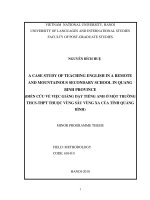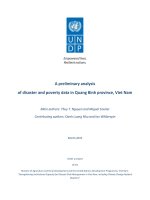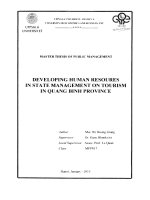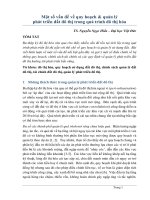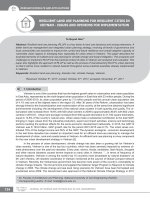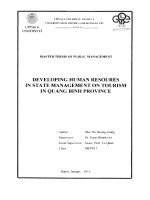BUILDING A MODEL TO SUPPORT DECISION-MAKING ON LAND USE PLANNING FOR RUBBER PLANTATIONS IN HILLY AREAS IN QUANG BINH PROVINCE UNDER THE IMPACT OF TYPHOONS
Bạn đang xem bản rút gọn của tài liệu. Xem và tải ngay bản đầy đủ của tài liệu tại đây (366.83 KB, 14 trang )
<span class="text_page_counter">Trang 1</span><div class="page_container" data-page="1">
<b>BUILDING A MODEL TO SUPPORT DECISION-MAKING ON LAND USE PLANNING FOR RUBBER PLANTATIONS IN HILLY AREAS IN </b>
<b>QUANG BINH PROVINCE UNDER THE IMPACT OF TYPHOONS </b>
<b>Pham Huu Ty<small>1</small>, Nguyen Van Binh<small>1</small>, Nguyen Ngoc Thanh<small>1</small>, Pham Thi Trieu Tien<small>1</small> </b>
<small>1University of Agriculture and Forestry, Hue University 102 Phung Hung, Hue city, Vietnam </small>
<small>Corresponding author’s email: </small>
<b>ABSTRACT </b>
<small>Quang Binh province, Vietnam had a large rubber area, more than 17000ha before 2013. However, due to the impact of many typhoons after 2013, over 7000ha of rubber trees were damaged. For sustainable rubber tree development, a planning support model is needed. The application of GIS and remote sensing is capable of supporting scenarios for planning to adapt to the effects of typhoons. This study uses Landsat 8 OLI satellite images from 2013-2020 to assess the damage level of rubber trees caused by typhoons and uses a multi-criteria method to build a model to support the rubber-plantation use land planning. The Maximum likelihood algorithm and the object-based image classification were combined to classify rubber plantation land cover before and after typhoons. The opinions of local experts and officials have been collected to determine the criteria for building a model to support planning decisions. The result of image classification shows that the overall accuracy is quite high, 84.4% and the Kappa coefficient is 0.69. There are 04 criteria selected to evaluate the impact of storms on rubber plantations, including slope, elevation, slope direction and distance from the coastline. The results also show that rubber trees were severely damaged in the land 10-20km from the coast, the area with the elevation <50m, the slope <5o, and the aspect in the East and Northeast. Based on these criteria, two planning options have been proposed for local reference.</small>
<b>1. INTRODUCTION </b>
Quang Binh province, Vietnam has a large rubber area, about 18.220 ha before 2013 with 9,120ha of newly planted rubber area, 9,100ha of rubber area in the business period, 10,285ha of smallholder rubber area and 7,935ha of large holders ’rubber area. However, due to the impact of many typhoons in 2013, more than 12.174ha of rubber trees were damaged (Nguyen, 2014). Despite such heavy damage, the local government and rubber planters of Quang Binh province still identify rubber trees as the main crops of the province because of its high economic efficiency over the years. In addition, provincial and local leaders determined that only big typhoons can damage rubber plantations. According to local statistics, there is only one big storm every 20 years like Typhoon Wutip in 2013 damaging rubber trees severely. For example, after the 2013 storm Wutip, two workshops were organized by Provincial People’s Committee, namely “Solutions to improve efficiency and sustainable development of rubber trees in Quang Binh province” and the People's Committee of Bo Trach district, which has the largest rubber plantation area and suffered the most damage, held a workshop on "Solutions to develop sustainable rubber trees." in Bo Trach district. Both identified rubber tree as the most effective crop. The workshops offered solutions including completing the process of planting, caring for and exploiting the conifer tree to guide the people, strengthening the state management of rubber tree varieties, proposing solutions to solve the problems about varieties, techniques to develop rubber trees in the most effective and sustainable way, planting rubber tree on contour lines and western-eastern direction. Regarding policies to support rubber tree planting, the district will integrate capital sources and programs to support households to plant new crops on areas damaged by storms of 1.5 million VND/ha (Phan, 2014; Nguyen, 2014). With these solutions and orientations, the damaged rubber tree areas were restored and replanted after Typhoon Wutip 2013 without a re-planning consideration to adapt to the effects
</div><span class="text_page_counter">Trang 2</span><div class="page_container" data-page="2">of the typhoons.
However, in 2017, there was a big typhoon named Doksuri with the same intensity as Typhoon Wutip in 2013 and damaged nearly 7,000 rubber trees in Quang Binh province (Nhat Linh, 2017) that changed the mindset of local leaders and people. The Provincial People’s Committee in Quang Binh province initiated a larger conference with different stakeholders to re-think about the future of rubber tree development in Quang Province under the impact of series of typhoons. With the consultation of stakeholders participating in the workshop, the provincial leaders have given instructions to focus on re-planning the area of rubber trees throughout the province. In which, the planning options follow two main directions: giving priority to the development of new rubber plantations on areas damaged by typhoons and only planting on areas that fully meet the requirements of technical processes; and for areas where rubber cannot be grown, strong wind levels and low-lying areas should be converted to short-term industrial crops (DARD, 2017). In 2019, Quang Binh Provincial People's Committee approved the Scheme on converting inefficient rubber trees to other crops in the period of 2019 – 2025 according to Decision No. 4909/QD-UBND dated December 19. 2019. This Scheme has outlined general principles of planning that focuses on maintaining 9,734.05 ha of rubber with high efficiency and little impact from typhoons and not planting new rubber tree, eliminating 9,100.4 ha of rubber in the current planning, and converting 3,866.97 ha of current rubber tree area damaged by typhoons to other crops (Quang Binh PCP, 2019).
Through this Schem, it is shown that the review and adjustment of the planning for planting rubber trees has been determined in terms of area size, however, decisions are made mainly based on statistics and data from localities, rubber plantation companies that lack a model to support decision-making based on specific criteria and a lack of spatial analysis consideration of areas that are not suitable for rubber plantations because of the high risk of typhoons. Therefore, this study uses GIS and remote sensing in combination with a multi-criteria decision support model to identify areas at high risk of being affected by typhons, thereby proposing scenarios and planning options for an adaptive planning and meeting the planning objectives of local leaders.
<b>2. MATERIALS AND METHODS 2.1 Secondary data </b>
Data and documents on natural, economic and social conditions of Quang Binh province are collected to obtain general information on the provincial portal of the People's Committee of Quang Binh province (Quang Binh People's Committee, 2020). The reports in the Proceedings of the Workshop on Solutions to improve the efficiency and sustainable development of rubber trees in Quang Binh province in 2017 (Quang Binh Department of Science and Technology, 2017), including 25 presentations by departments, departments, localities and scientific research units. The report on the project on restructuring crops on inefficient rubber plantations in Quang Binh province in the period of 2019-2025 is also collected with a lot of information related to planning, expert opinions on regulatory criteria plan.
<b>2.2. Remotely sensed data </b>
This study uses 02 types of remote sensing data from satellite, Landsat 8 OLI and digital elevation model from STRM satellite. Landsat 8 OLI satellite image data from 2013 to 2020 and the DEM STRM model were downloaded from the US Geological Survey website
</div><span class="text_page_counter">Trang 3</span><div class="page_container" data-page="3">The image in May 2013 was collected before the typhoon No. 10 in 2013 (named Wutip) occurred, the photo in October 2013 is the time right after the typhoon Wutip occurred. The image of April 2017 is the one before the time of typhoon No. 10 in 2017 (named Doksuri) and that of April 2018 is the time after the storm Doksuri happened 6 months because there is no image right after the typhoon happened. This research used images from April 2018 to evaluate the change of rubber cover and to assess the impact of Doksuri typhoon on the damaged rubber area in 2017. Image on July 2020 is used to assess the current status of rubber tree cover, and at the same time is used as input information for a model to support land use planning for rubber trees in Quang Binh province. The characteristics of the images are described in Table 1 as follows:
<b>Table 1. Landsat 8 OLI and DEM STRM satellite image data used in the study <small>Year </small><sup>Achieved </sup></b>
<b><small>Resolution (m) </small></b>
<b><small>Land cloud cover (%) 2013 </small></b> <small>17/05/2013 LC08_L1TP_126048_20130517_20170504_01_T1 126 48 30x30 23,47 </small>
<b><small>2013 </small></b> <small>08/10/2013 LC08_L1TP_126048_20131008_20170429_01_T1 126 48 30x30 0,39 </small>
<b><small>2017 </small></b> <small>10/04/2017 LC08_L1TP_126048_20170410_20180523_01_T1 126 48 30x30 28,83 </small>
<b><small>2018 </small></b> <small>13/04/2018 LC08_L1TP_126048_20180413_20180417_01_T1 126 48 30x30 12,13 </small>
<b><small>2020 </small></b> <small>23/07/2020 LC08_L1TP_126048_20200723_20200807_01_T1 126 48 30x30 12,88 SRTM DEM </small> <sup>SRTM 1 Arc-Second Global includes 03 images: n17_e105_1arc_v3, n17_e106_1arc_v3, </sup>
<small>n18_e105_1arc_v3 </small>
<i>(Source: </i>
<b>2.3. Data pre-processing: Landsat 8 OLI and SRTM DEM </b>
After the Landsat 8 OLI satellite image was downloaded, the image channels were checked and geometrically corrected on the WGS-UTM 48N system (north direction) to ensure consistency with the vector data. The Resample function of ArcGIS software was used to convert the spatial resolution to 30m x 30m since the original resolution of the image is 1 second, approximately 31 m. Then, the boundary polygon layer of Quang Binh province was used to extract the study area (RoI) using the Extract command in the Spatial Analyst/ArcGIS. The image channels were imported into the IDRISI TerrSet software to preprocess the image using the Stretch, Filter, and Panshapen tools. The Simple Linear method was used in the STRETCH tool to generate a new image with a new value that is determined by the upper and lower bounds of the values in the input image. Next, the FILTER tool was used to create a new image, where the value of each pixel was based on its value and the values of neighboring pixels in the input image. Finally, the PANSHARPEN tool has been applied to the high resolution (15m) panchromatic image channel (Band 8) to increase the spatial resolution of the low-resolution multispectral image channel (30m) through the technique by combining two image channels (Padwick, 2010). BandBQA image channels were used to remove clouds and cloud shadows using the Raster Calculator tool in ArcMap 10.8. After the image channels were enhanced, the 6.5.2 channel was used to generate the 6.5.2 pseudo-color composite image, which are also the image channels used for image interpretation and land cover maps of rubber trees in Quang Binh province.
</div><span class="text_page_counter">Trang 4</span><div class="page_container" data-page="4">The SRTM DEM elevation digitization model from 03 image scenes has been merged into 01 common image for the study area by the Create Mosaic Dataset tool in Arctool box of ArcMap 10.8 software.
<b>2.4. Image classification and rubber tree cover map </b>
<i><b>Step 1: Create training samples to classify </b></i>
To classify rubber tree cover, 07 types of cover have been identified that have a relationship with rubber tree cover, including: natural forest, planted forest, mixed vegetation, and other vegetation (agricultural and shrub cover). The layers are numerically coded from 1 to 7. The 6.5,2 channel pseudo-color composite image was used to create the decoding pattern layer. The rubber tree cover interpretation samples for the years 2013, 2017, 2018 were mainly selected based on Google Earth images with images corresponding to the month of Landsat 8 OLI satellites collected. The training samples were saved as *.kml and were transferred into ArcGIS using the Conversion/From KML tool to convert to shapefile. Training sample points were reviewed on the 6.5,2 composite color layer to adjust and check the attribute information of the sample layer.
Particularly in 2020, training samples were collected by a combination of Google Earth images with the field using a GPS Etrex 10 Garmin with an accuracy of ±2 m, Google map on iPhone mobile with positioning. These tools are very convenient for locating the real land covers in practice because it is possible to see the sampling location on Google Map and select samples right on Google Earth corresponding to the actual point being surveyed. The training samples are described as in Table 2 .
<b>Table 2. Training samples according to the pseudo-composite colors of 6,5,2 channel </b>
<b>Training sample </b>
<b>code </b>
<b>Land cover types <sup>Patterns of </sup>RGB=6,5,2 </b>
<b>Colors of 6,5,2 channel on the composite image </b>
with dark green
short-term agricultural crops)
Navy blue from light to dark blue
After having the training sample points, the 6.5,2 color composite image was used to create segments using the Segment Mean Shift tool in ArcGIS to group pixels that are adjacent
</div><span class="text_page_counter">Trang 5</span><div class="page_container" data-page="5">to each other. spectral characteristics of the same reflectance into the corresponding fragments (regions). After having the Segment layer of the 6.5,2 color combination, use the Training Sample Manager tool and the Select Segments tool in the Image Classification of Spatial Analyst to create sample areas. Sample areas are selected according to the reference of sample points collected from Google Earth images. After collecting all the decoding key samples for the 07 selected overlays, use the Create Signature File tool to create a reflectance layer file for the corresponding decoding key samples. The reflectance class file of these key samples is used to classify images according to the Maximun Likelihood Classification algorithm in the Image Classification module of Spatial Analyst.
After creating the Segment layer of the 6.5,2 color composite, the Training Sample Manager tool and the Select Segments tool in the Image Classification of the Spatial Analyst were used to create the sample regions. Sample areas were selected by reference from sample points collected from Google Earth images. After collecting all the samples for the 07 selected land cover types, the Create Signature File tool was used to create a reflectance layer file for the corresponding samples. The reflectance class of these key samples is used to classify images according to the Maximun Likelihood Classification algorithm in the Image Classification module of Spatial Analyst.
<i><b>Step 2. Classify images using the Maximum Likelihood Classification algorithm </b></i>
This study has combined 2 methods of supervised and unsupervised classification. The unsupervised classification method was performed by using the Segmentation image object segmentation tool. The result of object segmentation on a 6.5,2-channel composite image is groups of pixels (Segments) with similar reflectance spectra and similar object characteristics. Each segment is calculated and assigned a separate pixel value, if the segments have similar characteristics, the pixel value is the same, or in other words the same type of land cover. The difference between the segments is the value of the three RGB spectrum channels. After creating the Segments class, the Maximum Likelihood Classification tool in Image Classification was executed to classify the Segments according to the reflectance spectrum file created from step 1 (Training samples).
Please include a footer as shown below, in 10 pt bold face type. Odd-numbered pages should have the workshop title, and even-numbered pages the paper title, abbreviated if necessary.
<b>Step 4. Evaluate accuracy after classification </b>
To evaluate the accuracy after image classification, the representative classes of the land covers were selected based on the Google Earth image scenes corresponding to the time of Landsat 8 OLI image collection. The procedure is similar to creating the training sample class in step 2. For the classified images at the time of 5/2013, 10/2013, 2018, 2020, the total number of points used to evaluate the accuracy is respectively 84, 65, 66, 82 points. Particularly for the image of April 2017, the total number of points used to evaluate 7 object classes is 556 points. Because the province-wide data is too large, the scope of the study only tests the overall accuracy, the actual user accuracy, the interpretation accuracy, and the Kappa coefficient in 2017 by the error matrix through the Compute Confusion Matrix function in the Segmentation and Classification module. In the error matrix, there are the following indicators to evaluate classification accuracy including (Tsutsumida& Comber, 2015). Other years, classified images are evaluated by accuracy frequency between classified images and sampling points on Google Earth images based on the Frequency tool in the Arctool box of Arcmap. From there, the
</div><span class="text_page_counter">Trang 6</span><div class="page_container" data-page="6">percentage of accuracy was calculated.
<b>2.5. Building a model to support land use planning for rubber plantations based on GIS and remote sensing in typhoon-affected conditions in Quang Binh province </b>
This study combined the AHP and GIS methods based on expertise of local leaders and staff to construct some rubber tree plantation land use planning scenarios adapting to the impact of typhoons (Malczewski, 2006; Saaty, 2008; Ahmed et al., 2016; Akıncı et al., 2013). However, ranking of criteria was not done by local experts, it is conducted by estimation of damaged rubber tree scale based on criteria identified by experts. It is similar to crop suitability evaluation, but it determines non-suitable areas to plant rubber trees because of high risk of typhoon damage.
<i><b>Step 1: Determine criteria to evaluate by local experts and create thematic layers </b></i>
In order to come up with a planning adjustment method for rubber plantation areas, the criteria were discussed and consulted by 02 scientists studying rubber trees at Hue University of Agriculture and Forestry, 05 leaders at the Department of Agriculture and Rural Development in Quang Binh province, 02 technical staff of the Center for Agro-Forestry Planning in Quang Binh Province. Some criteria were also collected from the documents on Technical Procedures for Rubber Plantation of MARD. Most experts confirmed that most experts believe that the area of rubber trees broken and felt down by storms is located near the coast because this is the area that receives the first strong winds when approach the inland. Also, the coastal rubber area is mainly grown b smallholders, so the area is scattered and small, there is no belt to protect, and the quality of the trees is not good. This is the cause leading to this area suffering the most damage in recent typhoons. In addition, the damaged rubber tree areas are also affected by other factors such as elevation, slope, and slope aspect of the rubber plantation area. Other factors such as rainfall, soil type also have an influence but are not clear for the whole region because rubber plantation areas have similar soil types and there is little difference in rainfall in the region. Based on expert opinions, this study has selected 04 criteria, including elevation, slope, aspect, and distance to the coast, to identify areas that are not suitable for rubber trees because of their high-risk tolerance under the impact of typhoons.
The information layers for slope, elevation, slope direction, and distance from the coast were built from the STRM DEM elevation digitized model using the Slope, Aspect, Reclassify, and Multiple Ring Buffer analysis tools in ArcMap. The slope layer is subdivided into classes 0-5<sup>o</sup>, 5-15<sup>o</sup>, 15-20<sup>o</sup>, 20-30<sup>o</sup>, and >30<sup>o</sup>. The aspect layer is divided into eight directions: north, northeast, east, southeast, south, southwest, west, northwest. The elevation layer is classified into layers: under 50m, 50-100m, 100-200m, 200-300m, >300m. The distance class from the coastline is divided into zones as follows: <10km, 10-20km, 20-30km, 30-40km, 40-50km, 50-60km, 70-80km. Criteria layers are converted to shapefiles for use in the next step.
<i><b>Step 2. Raking the scale of rubber tree damage according to the four criteria </b></i>
This study used the second layer of rubber trees damaged by Typhoon Wutip in 2013 to assess the damage levels of rubber trees based on information layers according to selected criteria. The 2013 damaged rubber tree cover and the assessment criteria layer were superimposed through the Intersect tool in ArcGIS. Then, the Dissolve tool was exploited to combine the criteria classes and calculate the damaged area for the subclasses in the criteria,
</div><span class="text_page_counter">Trang 7</span><div class="page_container" data-page="7">thereby calculating the percentage and ranking the influence of the subclasses in the criteria layers.
<i><b>Step 3. Developing scenarios for adjusting rubber tree planting planning </b></i>
To adjust the rubber tree planting planning, this study overlayed the 2018 rubber tree layer with the evaluation criteria layers by Intersect tool in ArcGIS to create land units according to the criteria. Then, the Selection tool with logical overlapping commands (And, Or…) was used to select the unsuitable land units to remove out of the 2018 rubber tree areas because of the greatest typhoon-induced damage level.
After obtaining the planning adjustment scenario, the results were sent to experts of Department of Agriculture and Rural Development, Department of Natural Resources and Environment, and Center for Agro-Forestry Planning in Quang Binh province for comments and synthesis for adjustment.
<i><b>Step 4. Editing the map of the adjustment method of rubber tree planning: After </b></i>
removing the unsuitable land units, the remaining rubber tree area was edited to include in the adjustment map layer for rubber tree planning.
<b>3.2. Training samples </b>
Figure 2 and Table 3 show that the segment training samples have different combinational color values, the distribution among the channels has a match. This distinction helps to classify land cover types quite well. In addition, the training samples are tested to calculate the scores of the samples. The mean score for all samples is 0.77, for the following samples: rubber tree (0.75); shrubs (0.63); bare soil (0.75); water (0.97);natural forest (0.71);and mixed vegetation (0.93).Thus, the training samples used to classify images ensure good quality.
</div><span class="text_page_counter">Trang 8</span><div class="page_container" data-page="8"><b>Figure 2. Average distribution of image channels 6-5-2 compared with </b>
<i><b>interpreted objects. Note: 1…7 is land cover code </b></i>
<b>Bảng 3. Pixel value of composite images for segment samples Land cover </b>
<b>Pixel value of composite images </b>
<b>3.3. Accuracy assessment after classification </b>
The results of the accuracy evaluation are as follows: the accuracy rate of May 2013 is 88.3%, October 2013 is 82.6%, and 2018 is 88.3%, and 2020 is 82.9%. For image classification as of 4/2017, the accuracy assessment is done by the error matrix through the Compute Confusion Matrix function in the Segmentation and Classification module. The evaluation results shown in Table 4 show that the overall accuracy is high, 84.4% and the Kappa coefficient is 0.69. This result shows that the interpretation results have high reliability (Tsutsumida et al., 2015).
050100150200
</div><span class="text_page_counter">Trang 9</span><div class="page_container" data-page="9"><b>Table 4. Confusion matrix assessment for image classification in April 2017 </b>
Land cover
Bare soil
Mixed
vegetation <sup>Water </sup>
Natural forest
Plantation
forest <sup>Shrubs Total </sup>
<i>User’s accuracy </i>
<b>Figure 2. Rubber tree cover 2018 in Quang Binh Province </b>
</div><span class="text_page_counter">Trang 10</span><div class="page_container" data-page="10"><b>Table 4. Changes of rubber tree land cover area in the period 2013-2020 Years 2013 2017 2018 2020 </b>
<b>Change (+/-) 2013-</b>
<b>2017 </b>
<b>2020 </b>
<b>2017-2020 </b>
2013-Rubber land cover area
(ha)
Table 4 shows that the area of rubber trees decreased sharply in the period 2013-2020, by nearly 45%, an average of nearly 8% of the total area each year. In which, the period 2013-2017 and the period 2017-2020 reduced more than 25% of the total area.
<b>3.5. Results of building a model to support land use planning for rubber trees based on GIS and remote sensing in the affected conditions of typhoons </b>
<i><b>3.5.1. Maps of criteria layers </b></i>
<b>Figure 3. Maps of criteria layers: slope, aspect, elevation, and distance to coastline </b>
<i><b>3.5.2. Typhoon-induced rubber tree damage for each criterion </b></i>
The land cover map layer for rubber plantations damaged by the 2013 Wuptip typhoon and the attribute map layers including slope, elevation, slope direction and distance from the coastline were superimposed by the command Intersect to determine the area of damaged rubber trees according to the hierarchical information layers. The results are represented in
</div>
